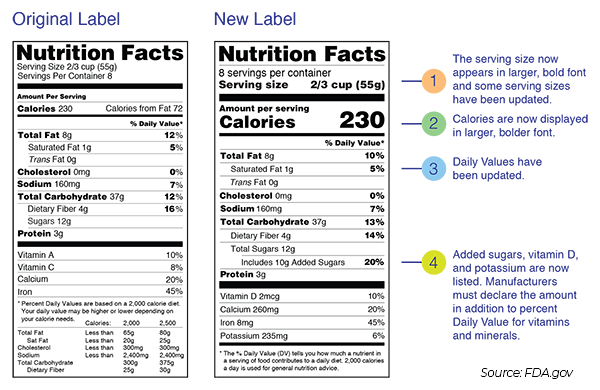FDA rolls out new Nutrition Facts label for packaged food and drinks
Changes include easier-to-read calorie and serving size data, updated nutrition information and quantity of added sugars, while calories from fat is no longer listed.
March 27, 2020

The Food and Drug Administration has released a new Nutrition Facts label on packaged foods and beverages, calling the change for first major update in more than 20 years.
Changes to the label are based on updated scientific information, new nutrition research and input from the public, the FDA said. Along with new information, the label features a refreshed design to make it easier for consumers to make informed food choices and develop healthy eating habits, the agency said.
Four key elements of the Nutrition Facts label have been changed: serving size, calories, Daily Values and nutrients/added ingredients. Serving size now appears in a larger, bolder font, and some serving sizes have been updated to better reflect the amount that people today typically eat and drink.

The FDA noted that serving size isn’t a recommendation of how much to eat, and the nutrition information listed on the label is usually based on one serving of the food. Some containers, though, also may have information displayed per package, which could contain more than one serving.
Similarly, calorie count is shown in a bigger and bolder font to make the information easier to find, according to the FDA. For general nutrition advice, the recommendation is 2,000 calories a day, but that level may be higher or lower depending on age, sex, height, weight and physical activity level, the agency said.
Daily Values for nutrients have been updated, which may make the percent Daily Value (%DV) higher or lower on the new Nutrition Facts label, the FDA reported. Generally, the updated label says 5% DV or less of a nutrient per serving is considered low, while 20% DV or more of a nutrient per serving is considered high. The footnote at the bottom of the label also better explains percent Daily Value, which shows how much a nutrient in a serving of food contributes to a total daily diet.
In terms of nutrient information, calories from fat has been removed from the label because research shows the type of fat consumed is more important than the amount, according to the FDA. Vitamins A and C also have been taken off “since deficiencies of these vitamins are rare today,” the agency said, adding that those vitamins can be included in the label on a voluntary basis.
Nutrient additions to the label include added sugars, defined as sugars added during the processing of foods (such as sucrose or dextrose), foods packaged as sweeteners (such as table sugar), sugars from syrups and honey, and sugars from concentrated fruit or vegetable juices. “Consuming too much added sugars can make it hard to meet nutrient needs while staying within calorie limits,” the FDA noted. Vitamin D and potassium, too, are now required to be listed on the label “because Americans do not always get the recommended amounts,” according to the agency. “Diets higher in vitamin D and potassium can reduce the risk of osteoporosis and high blood pressure, respectively.”
The FDA said calcium and iron will continue to be listed on the label because Americans don’t always get the recommended amounts, which can lower the risk of osteoporosis (calcium) and anemia (iron).
In support of the updated Nutrition Facts label, the FDA has launched an education campaign called “The New Nutrition Facts Label: What’s In It for You?”. The initiative includes outreach through social media, indoor/outdoor advertising, videos and consumer-friendly downloadable educational materials.
The FDA’s website provides an overview of the campaign and links to materials for dietitians, physicians, health educators and teachers. A fact sheet from the FDA is available to download at the bottom of this page, and others are available on the agency's website.
The social media toolkit contains newsletter text, social media messages, images, campaign videos and fact sheets for social sharing. And the “What's New” page can help you understand the label updates.
The campaign is part of the FDA's Nutrition Innovation Strategy. In 2018, the agency announced the Nutrition Innovation Strategy to reduce preventable death and disease related to poor nutrition. To that end, the FDA said, the new Nutrition Facts label campaign supports consumer education.
 This piece originally appeared on Supermarket News, a New Hope Network sister website. Visit the site for more grocery trends and insights.
This piece originally appeared on Supermarket News, a New Hope Network sister website. Visit the site for more grocery trends and insights.
About the Author
You May Also Like


